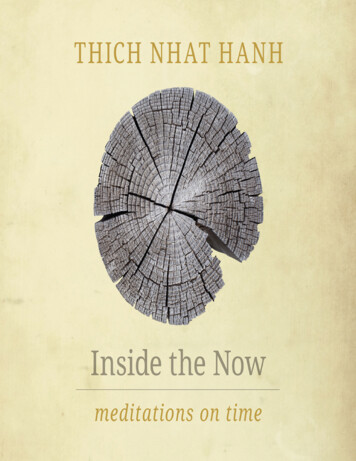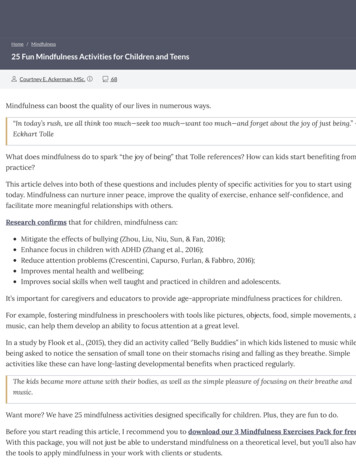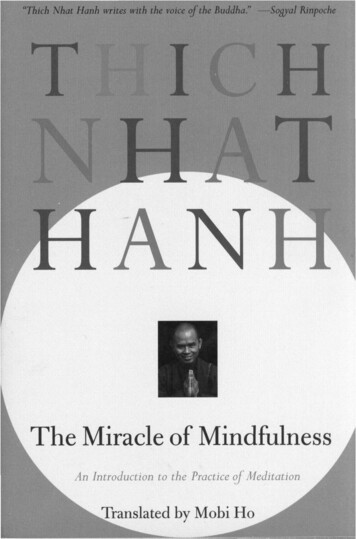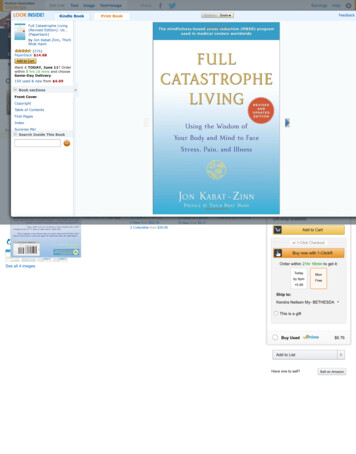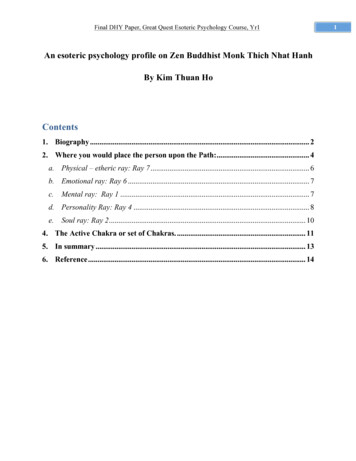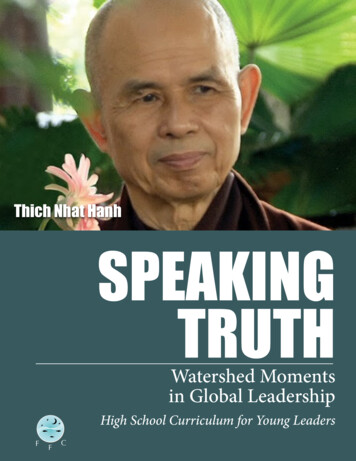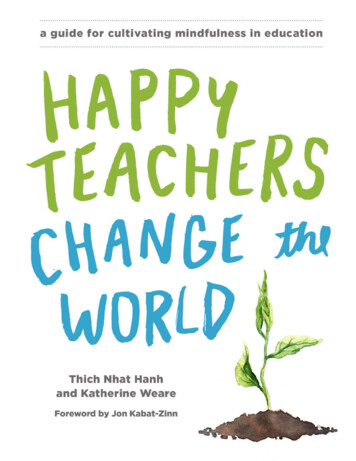
Transcription
“A wonderful resource for those searching for ideas to bring mindfulness totheir own lives as well as to their students. The voices and expertise ofclassroom teachers resound throughout this rich volume.”—Mark T. Greenberg, PhD, Pennsylvania State University“At last: a book about mindfulness meditation for teachers—and thus forstudents—that preserves the depth and the wisdom of its Buddhist roots. And apractical one at that, full of elegant suggestions that today’s stressed youngstersought to jump at. It will do much good.”—Guy Claxton, PhD, What’s the Point of School? and Building Learning Power“The contributions of Thich Nhat Hanh and Katherine Weare to the field ofcontemplative pedagogy are many. With this important book they bring not onlytheir own depth of experience to the task, but also that of hundreds of teachersto aid teachers and students everywhere in attaining genuine happiness throughthe practice of a mindful and compassionate education.”—Arthur Zajonic, PhD, The Heart of Higher Education“This book is both a joy to read and a very practical resource for teachers whowant to pass on the practice of mindfulness to their students. Grounded inresearch evidence and in the experience of teachers who have travelled thispath before, it shows the transformative power of mindfulness to bringeducation to its senses. A must for any teacher in any setting who has everwondered if what they are doing could be done with more fun and less effort.”—Sarah Stewart-Brown, PhD, Warwick Medical School, UK“This book should not only be a required reading for teachers and educationalpersonnel, but also for those who are concerned about the future of ourchildren. The contemplative practices and experiential exercises are indeedcapable of fostering more resilient, happier and compassionate teachers andpupils, and thus have the potential to change the world.”—Rony Berger, PsyD, The Center of Compassionate Mindful Education, Tel AvivUniversity; Ben Gurion University; The Center for Compassion and AltruismResearch and Education at Stanford University
“What an important book! Thich Nhat Hanh is a global leader dedicated tobringing mindfulness, happiness, well-being, and peace to educators, students,and society. He has keenly felt the responsibility of helping young people andhas dedicated his whole life to the mission of communicating timeless,universal values in an accessible way. Katherine Weare is an educator withdecades of experience in bringing well-being and mindfulness into schools anduniversities .To have these two co-authoring this book is a wonderful andprecious gift to us all.”—Vidyamala Burch, Mindfulness for Health and Mindfulness for Women“For educators everywhere who yearn for wisdom and partnership in theircourageous efforts to form young hearts and minds in an increasinglyfragmented world, this book is a trustworthy and wise companion It isessential reading for all those interested in mindfulness in education today.”—Robert W. Roeser, PhD, co-editor of Handbook of Mindfulness in Education“In this outstanding book, Zen master Thich Nhat Hanh, with his profoundteachings and deep practices, and Professor Katherine Weare, with herconsiderable experience of emotional education, child development, andmindfulness in education, collaborate to provide a step-by-step detailedsequence of mindful practices for everyday activities such as breathing,walking, eating Beautifully written, highly accessible, knowledgeable anddeeply practical, this book will be an invaluable to teachers and studentsalike.”—Paul Gilbert, PhD, OBE, Centre for Compassion Research and Training,University of Derby, The Compassionate Mind“ ‘Mindfulness is a path not a tool.’ Thich Nhat Hanh, Katherine Weare, and thePlum Village teachers illuminate this path with precision and clarity. Enlivenedwith the diverse and precious experiences shared by those who walk the pathin their classrooms and lecture halls across the globe, this book is anextraordinary offering to all educators and their students.”—Christine Burke, PhD, Australian Catholic University“Happy Teachers Change the World is an enormously valuable compendiumof mindfulness practices for those working in education.”
—Richard Burnett, Mindfulness in Schools Project, UK“Bursting with wisdom and compassion in an era when our teachers andstudents need it more than ever, this book is a gift to the future of ourcommunities and larger society. [It] reminds us that the best way to cultivatehappy, mindful children is to cultivate happiness and mindfulness in the adultsaround them Nhat Hanh and Weare teach us exactly that, drawing deeply onboth science and spirit to nourish the seeds of mindfulness in ourselves andfuture generations, truly changing the world.”—Christopher Willard, PhD, Growing up Mindful and Child’s Mind“When I first read this book a single word came up over and over, ‘beautiful.’The book’s intention; the potential to change the culture of schools, to affect thetrajectory of young people’s lives; the confluence of ancient wisdom andcontemporary education practice; the clarity of the writing—beautiful. I hopethis proves to be a seminal text for educators around the world with an interestin how best to support the learning and well-being of young people and thosewho teach them.”—Willem Kuyken, PhD, Oxford Mindfulness Centre, University of Oxford[It]“This wonderful book gives us wise insights and tools to integrate mindfulnessinto education, in order to enhance the full human-beingness of teachers,students, and parents. [It] allows us to teach best what we most need to know—the art of living.”—Nimrod Sheinman, ND, Israel’s Center for Mindfulness in Education, The Centerfor Mind-Body Medicine, and Mindful Schools, Israel
Parallax PressP.O. Box 7355Berkeley, CA 94707parallax.orgParallax Press is the publishing division of Unified Buddhist Church, Inc. 2017 by Unified Buddhist Church, Inc. and Katherine WeareAll rights reservedCover and text design by Debbie BerneIllustrations by Br. Phap BanThanks to Yvonne Mazurek and Elli Weisbaum for assistance in preparing the book.Author photograph Thich Nhat Hanh Richard FridayAuthor photograph Katherine Weare Katherine WeareNote: This book is intended for teachers, children, and individuals of all physical and mentalabilities, including those with limited mobility and/or vision and hearing. Please feel free tomodify the language to suit the situation you’re in and the needs of the people involved. Youcan add “move” when the text says “walk,” “straighten up” when it says “stand.” When it talksabout being in touch with the earth while walking, you can add, “I’m aware of my connectionwith the earth through the legs or wheels of my chair,” and so on.Ebook ISBN 9781941529645Library of Congress Cataloging-in-Publication Data is available upon request.v4.1a
contentsCoverTitle PageCopyrightforeword jon kabat-zinnletter to a young teacher thich nhat hanhpreface: a vision for education the plum village communitypreface: the plum village contribution to the field of mindfulness in educationkatherine wearepart one: core practicesonethe breathbreathe, you are alive! thich nhat hanhteaching notes on getting in touch with our breathcore practice: getting in touch with our breathmindful breathing in our lives and our teachingtwothe bell of mindfulnessan ambassador for peace and happiness thich nhat hanhteaching notes on the bell of mindfulnesscore practice: inviting the bellcore practice: listening to the bellthe bell of mindfulness in our lives and our teaching
threesittingsitting like a mountain thich nhat hanhteaching notes on sitting mindfullycore practice: short sitting practiceteaching notes on finding the best sitting positionsitting mindfully in our lives and our teachingfourwalkingwalking just to walk thich nhat hanhteaching notes on mindful walkingcore practice: mindful walking in a circlecore practice: longer mindful walkmindful walking in our lives and our teachingfivethe bodybody and mind united thich nhat hanhteaching notes on the body practicesteaching notes on awareness of body and breathcore practice: awareness of the body and the breathteaching notes on ten mindful movementscore practice: ten mindful movementsteaching notes on deep relaxationcore practice: deep relaxationteaching notes on lying down in the classroomawareness of the body, and body practices, in our lives and our teachingsix
eatingthe cosmos in a carrot thich nhat hanha food contemplationteaching notes on mindful eatingcore practice: tangerine meditationcore practice: eating a snack mindfullycore practice: eating a whole meal mindfullymindful eating in our lives and our teachingseventaking care of our emotionsno mud, no lotus thich nhat hanhteaching notes on taking care of our emotionsteaching notes on using our breath to get in touch with our emotionscore practice: using our breath to get in touch with our emotionsteaching notes on tree in a stormcore practice: tree in a stormteaching notes on pebble meditationcore practice: pebble meditationtaking care of emotions in our lives and in our teachingeightbeing togetherdeep listening and loving speech thich nhat hanhteaching notes on being togethercore practice: sharing in a circle with deep listening and loving speechteaching notes on beginning anewcore practice: beginning anewbeing together in our lives and in our teaching
part two: bringing it all togetherninecultivating mindfulness in ourselvesmindfulness begins with ourselveswhat do teachers gain from practicing mindfulness?becoming more mindful ourselves: first stepsdeepening our practice: going on a retreatbuilding a local communitycultivating mindfulness in our everyday livestencultivating mindfulness in our students and classroomscultivating mindfulness in our studentsrelating skillfully to student behaviorpreparing to teach students mindfulnessmethods and approaches for teaching mindfulnessmindfulness and learningintegrating mindfulness within an ethical and social and emotional curriculummindfulness and the mainstream subject-based curriculumwhen mindfulness is difficult to teachelevencultivating mindfulness across school and universitycommunitiescultivating a sense of familysharing mindfulness with our colleaguesreaching out to students’ familiesa whole-school, comprehensive approachhappy teachers change the world
appendicesa. summaries of the core practicesgetting in touch with our breathinviting and listening to the bellmindful sittingmindful walkingawareness of the body and the breathten mindful movementsdeep relaxationmindful eating (tangerine meditation)using our breath to get in touch with our emotionstree in a stormpebble meditationcircle sharingbeginning anewb. the five mindfulness trainingsc. the five contemplations before eatingd. what next? resources to develop your personal practice and yourteaching of mindfulnessnotesacknowledgmentscontributors to this bookAbout the Authors
forewordJON KABAT-ZINNWhat you have in your hands is a uniquely important gift—we could equallywell say, transmission—from Thich Nhat Hanh late in his remarkable life. Asyou will see, it is a product of his deep affection for the young and his enduringappreciation of the necessity of a wise and kind education for futuregenerations. On every page, you can feel the honoring of those who take on thiscalling, so often unrecognized, and the enormity of what they do every day inthe service of shaping, transforming, and healing this world of ours from thebottom up, generation by generation—namely teachers. It is equally the productof an inspired collaboration with coauthor Professor Katherine Weare, aneducator and mindfulness teacher, who has been studying the effects ofmindfulness training in education for many years, and an advisory team ofwriters, Thay’s senior students, from the Plum Village community. Togetherthey have crafted a multifaceted and highly user-friendly training manual forteachers that can be used to bring mindfulness in a variety of ways into yourclassroom and into your own life.Mindfulness is a practice that can help students of all ages tune theirinstrument of learning. By that, I mean their entire being—body, mind, heart,and brain as well as their relationships among themselves as learners, andthus, a social/environmental dimension that is also crucial to optimal learningand inquiry. Cultivating the very capacity to pay attention is foundational.Teachers need their students to pay attention to and inquire with discernmentinto what is most important. It really helps to purposefully develop thatcapacity as a skill—one which can ignite and sustain a lifelong curiosity andlove of learning, as well as an effective and insightful grasp of whateverspecific material is being studied. Increasingly, teachers around the world arecoming to this realization .Why not teach their students the how of payingattention and of deep listening rather than simply exhorting them to payattention, as so often happens in the classroom when the teachers themselvesare stressed beyond their limits? The approach to mindfulness offered in this
volume is a natural pathway for developing that capacity.Mindfulness is all about paying attention and about the awareness, inquiry,discernment, and wisdom that arise from careful and care-filled attending.Deep listening and attentive reflection are linked to learning to trust one’s ownperceptions and experiences. They tap into imagination and creativity tofacilitate peeling back the outer layers of appearance to reveal the underlyingprocesses at work, and then, coupled with the requisite social skills alsodeveloped through the practice of mindfulness, sharing those moments of bothinsight and frustration openheartedly in a classroom community with others.Awareness (mindfulness) is a natural human faculty that is probably not asappreciated within educational circles to the degree that thinking isappreciated. Yet the two in combination are demonstrably more powerful thanthinking by itself. Awareness is bigger than thought, in that it can hold anythought, recognize it as a thought rather than a fact, and thus facilitate aninquiry into whether it is true, complete, accurate, and germane to or perhapsobscuring of the matter at hand. This is an essential skill for developingcritical thinking, and, interestingly, also for cultivating emotional intelligenceand thus, a greater effectiveness in regulating one’s emotions and emotionalreactions. When thinking is complemented by awareness, it is a more powerfuland vetted thinking, giving us greater confidence in what we know, and also,hopefully, recognizing what we don’t know, an equally important domain ofeducation, creativity, and life.Although the authors are clearly and unapologetically grounded in an ancientand venerable Buddhist tradition from which mindfulness received its mostelaborate and precise articulation thousands of years ago, they have gone togreat lengths to frame their work in a universal, wholly mainstream, andsecular way. That is not so difficult to do, as the essence of mindfulness is infact universal—what many of us have come to think of and experience as “away of being” and “a way of being in relationship with what arises,” and thus,a deep inquiry into relationality itself. Much of education is predicated ondoing and on acquiring knowledge. A lot of students get lost along the way anddon’t necessarily see the relevance of what they are required to learn to theirlives. The irony is that when our learning and our interest are grounded in thedomain of being, the domain of embodied wakefulness, the doing (and thelearning) that arise out of that “non-doing” is far more robust and nuanced and
effective. This is attested to by the up-swelling of the mindfulness in schoolsmovement throughout the world, as more and more teachers are finding itnecessary to ground their classes in full presence from the very beginning as apractice, rather than merely “taking attendance,” which may denote that thestudent’s body is in the room, but, ironically, not necessarily the student’s mindand heart. The universality of this approach is also evident from the many nonBuddhist teachers from all around the world who are practitioners ofmindfulness and who have contributed anecdotes and recommendations to thebook based on their own classroom experience. As the authors also point outand cite, there is a growing and already fairly robust scientific evidence basefor the efficacy of training the basic faculties of mind (all the senses, andawareness itself, as well as the emotions of kindness and compassion), evenfrom an early age, so that they can both catalyze optimal learning and ignite anongoing curiosity about life itself.Schools and universities have long recognized the importance of PE(physical education) and sport, since the benefits of movement and exerciseacross the lifespan, starting in childhood, are well established. Yet we allknow that thinking and talking about exercising or moving is not enough. Forthe true benefits to accrue and be experienced, you have to actually exerciseyour body and its muscles and bones—pretty much every day. PE and sportalso bring down stress levels from too much mental focusing over too long aperiod of time, and allow the students an occasion to restore both mental andphysical balance. In a similar way, mindfulness training in the schools can bethought of as a kind of MT (mental training) or ME (mental education) wherethe muscle of mindfulness is being awakened, exercised, and strengthenedthrough ongoing practice.The world is changing so fast that we don’t actually know what intellectualfoundations and skills will be most important to acquire for the cominggenerations. But we certainly do know that to be creative, love one’s work,navigate the digital/analog divide, and experience a lifetime of learning, it willbe essential for young people of all ages to develop the skill of being present.This includes learning how to befriend and trust one’s own inner experience,and learning how to navigate the inner landscape of mind, body, and heart, andthe outer landscape of learning with others. Tapping into one’s own capacityfor creativity and imagination across the lifespan in this way is an essential
prescription for success, well-being, and yes, as the title of the book suggests,happiness.One of the major principles here is that mindfulness needs to beincorporated into the life of the teacher before he or she can effectively bring itinto the classroom. If you are a teacher and are new to mindfulness, this bookshows you with great precision how to go about developing your ownmindfulness meditation practice, as well as how to creatively bring it into yourclassroom in the service of your students and their well-being, emotionalintelligence, and joyful learning. Please note that there is no one right way forgoing about it. The beauty of this approach is that it gives you a range ofoptions to experiment with, and ultimately reminds you that it is your owncreativity, nurtured by your meditation practice, which provides thoseendlessly novel and creative opportunities. In a very real way, your studentswill call that wisdom and discernment out of you. They will be your greatestmindfulness teachers.The virtue of this approach is that it can come directly out of your love ofteaching, and out of your aspirations for your pupils and students to thrive,shaped and informed by your own intuitions and expertise, all grounded in yourown moment-to-moment mindfulness practice. As far as I can see, wonder,learning, and insight just keep growing out of that nurturing soil.One of Thay’s early books to have a major impact in the West was calledThe Miracle of Mindfulness. Here, in this book, is the miracle made real. Ioffer my own personal gratitude for this inspiring contribution to making ourworld a better and more loving and compassionate place.Jon Kabat-ZinnBerkeley, CaliforniaFebruary 22, 2017
letter to a young teacherTHICH NHAT HANHDear Colleagues,I am a teacher and I love my job, and I know very well that you love your jobtoo. All of us want to help young people to be capable of being happy and ofmaking those around them happy.Our mission as teachers is not just to transmit knowledge, but to form humanbeings, to construct a worthy, beautiful human race, in order to take care of ourprecious planet.I am very fortunate because the people—especially the young people—withwhom I work and live have the same ideal. They want to learn to transformthemselves so they can live happily and help others live happily too. So, everytime I walk into my classroom there is happiness and mutual understandingbetween teacher and student, and a brotherhood and sisterhood which makesthe work of teaching and studying much easier.I always get to know about the life of my students. I tell them about my owndifficulties and dreams so that communication between us may always bepossible. We know that the children—the students of today—have a lot ofsuffering in them. This is often because their parents suffer. Their parentscannot communicate with each other, and it is not easy for the parents andchildren to communicate with each other either. There is a sort of loneliness, akind of vacuum in the child, and the child tries to fill up this emptiness withvideo games, movies, television, food, drugs, and other things like these.You know this all too well.There is an enormous amount of suffering in young people, and this makesthe work of teaching a lot more difficult. We ourselves, as teachers, havedifficulties too. We try our very best, but the environment, our family, and thecolleagues we work with have a lot of suffering in them.If we as teachers, along with our colleagues, are not happy, how can weexpect the children to be happy? This is a very important question! We may not
yet have enough patience, understanding, freshness, or compassion to be ableto confront all this suffering. There is a certain spiritual dimension we need tohelp us to transform and to begin to help the people around us—our familymembers, our partner and, then, others—to transform. If we succeed in thispractice we become more pleasant and compassionate.Bringing Our Mind Back to Our BodyThe first step is to come back to yourself—the way out is in. Come back toyourself to be able to take care of yourself: learn how to generate a feeling ofhappiness; learn how to handle a painful feeling or emotion; listen to your ownsuffering, so that understanding and compassion can be born and you willsuffer less. This is the first step and, as a teacher, you have to be able to dothis. You have to begin with yourself. We have practice methods to help us dothis, and we can practice these together joyfully.Through mindful breathing we can bring our mind back to our body and takecare of our body first. After you have done this for yourself, you can helpothers to do the same. When you have not changed yourself it is very difficultto help the other person change so that he or she will suffer less. With morepeace and gentleness in yourself, you become more pleasant and that is whyyou can much more easily help the other person to suffer less.There is tension and pain in our body. With the practice of mindfulness, youcan come back to your body, recognize the tension and suffering which ispresent in the body, and breathe in such a way that you can let go of thissuffering. A half hour or even five minutes of practice can already change thesituation.Mindfulness is a kind of energy that helps us to be fully present in the hereand the now, aware of what is going on in our body, in our feelings, in ourmind, and in the world, so that we can get in touch with the wonders of life thatcan nourish and heal us.The Art of LivingThe practice of mindfulness is the practice of joy. It is an art of living. Withmindfulness, concentration, and insight you can generate a feeling of joy andhappiness whenever you want. With the energy of mindfulness you can also
handle a painful feeling or emotion. If you do not have the energy ofmindfulness you will be afraid of being overwhelmed by the pain and sufferinginside.Mindfulness is always mindfulness of something. When you practicebreathing in and out mindfully, that is called mindfulness of breathing. Whenyou practice walking mindfully, that is called mindfulness of walking. Whenyou eat your breakfast mindfully, that is called mindfulness of eating. You donot have to sit in the meditation hall to practice mindfulness. You can do itwhen taking a shower, while driving a car, when at school or working on aproject, and in your relationships with other people; and you can practicemindfulness whether you are standing, walking, sitting, or lying down. Theenergy of mindfulness generated by awareness of breathing, or awareness ofyour steps while walking, helps bring your mind home to your body, and whenmind and body are together you are well established in the present moment.Life with all its wonders, with all its refreshing and healing elements—joy,happiness, and peace—is available only in the present moment. The past isalready gone and the future is not yet there; the present moment is the onlymoment in which you can be truly alive.Mindfulness always helps increase concentration, and mindfulness andconcentration together can bring insight. When you breathe in mindfully,concentrating on your in-breath, you may discover simple but essential things,like the insight that you are alive and that you have a body. “I know I have abody”—that is already insight! I am alive, I am free, I am present in the hereand the now. “Breathing in, I know I am alive, and to be alive is a miracle—the greatest of all miracles.” When you breathe in, you know you are alive—because someone who is dead cannot breathe in anymore. As you breathe out,you can already celebrate the fact that you are still alive. Your lungs are strongenough for you to enjoy your in-breath; your feet are strong enough to walk, andallow you to touch the earth with every step. So many conditions for happinessare available. With mindfulness and concentration, insight continues to arise.Stop RunningThere are so many conditions of happiness. We don’t need to have more. If wewere to take a pen and write down the conditions of happiness that we alreadyhave, one page would not be enough, two pages would not be enough—even
ten pages would not be enough. Writing down our conditions of happiness is animportant meditation.When you recognize the conditions of happiness you already have, you canbe happy and joyful right in the here and the now. Many people mix uphappiness with excitement, but excitement is not exactly happiness. Whenyou’re excited, there’s not enough peace in you, and the happiness isn’t real.Mindfulness is a kind of practice that helps us to understand what truehappiness is—it’s not something made with objects of craving like fame,power, wealth, and sensual pleasures, but is made with understanding andcompassion.True happiness means that you don’t need to run after anything anymore.There’s a feeling of satisfaction being in the here and the now, when yourecognize you have so many conditions for happiness, wherever you are. If youcan do that, you can generate a feeling of happiness and joy at any time. We cancreate joy and happiness not only for ourselves, but also for other people. Youremind others with your mindfulness—it can be contagious. You remind themthat we are in a wonderful world, that they can touch the wonders of life thatare available, and that can make them happy. If you’re joyful, happy, andaware, you light up the lamp of happiness and joy in others, because in each ofus there is a seed of mindfulness, a seed of awareness. This is an art, and it’snot difficult. As a teacher, you can perform that miracle in just a few seconds,and you can make the students in your class happy.Deep CommunicationNowadays people use many means of communication, like cell phones,television, and computers, but communication has become very difficultbetween partners, father and son, and mother and daughter. It’s not because youhave a lot of electronic devices that you improve the quality of communication.If you do not understand yourself, if you cannot be in touch with yourself, if youdo not know what is the cause of your own suffering, fear, and anger, youcannot communicate with yourself. And when you cannot communicate withyourself, how can you communicate with another person?That is why going home to yourself to get in touch with your body, yourfeelings, your perceptions, and your suffering—understanding yourself—iscrucial before you can help another person. That is why we propose that
teachers and students sit together to tell each other about the suffering inside.We should have the time—we should be able to afford the time—to do that.True communication should be done on that level: understanding the sufferinginside, understanding the suffering in the other person. We need to teach this tothe younger generation.Deep listening and loving speech, practiced with our students, helps removethe obstacles between teachers and students. If the students understand yoursuffering, they will not continue to make you suffer anymore. If we understandtheir suffering, we will know how to help them to suffer less. Together weimprove the quality of teaching and of learning, and the classroom becomes avery pleasant place to be for everyone. It is possible to be happy together asteachers and students.Mindfulness practice applied to listening and speaking can help us restorecommunication with ourselves because we can learn to listen to our ownsuffering. We don’t have to try to get away from ourselves; we don’t have tocover up what is unpleasant in us. We try to be there for ourselves, tounderstand ourselves, so that we can transform. If you know how to listen withcompassion and love you can
“The contributions of Thich Nhat Hanh and Katherine Weare to the field of contemplative pedagogy are many. With this important book they bring not only their own depth of experience to the task, but also that of hundreds of teachers to aid teachers and s
